Liza and Fred Murrell had their eyes on a stately North Water Street home since they first discovered Martha’s Vineyard twenty-seven years ago. The Canadian couple and their young family established a summer tradition of vacationing at the Harbor View Hotel, their children skipping along Edgartown Harbor with crabbing nets, fishing poles, and ice cream cones. More than just being enamored with the charms of the summer scene, “It was Fred who was in love with the Vineyard, and it was a place my children could be free,” said Liza. “Another plus was an African American, Black community that’s so rich.”
Before long, the Murrells and their four children moved from the hotel to another summer gathering spot: they built a house on Simpsons Lane, at the edge of the Chappy Ferry line. But even after completing an elegant home there, designed by architect Patrick Ahearn, Liza would walk the row of captains’ houses on North Water Street.
“I was always pointing out this house and that house – the home we hoped to have one day.” In 2013, Liza’s vision became a reality when one of those North Water Street properties became available. “I went to an open house at North Water Street and I called my husband right away,” she said. “It was too good to be true. We scooped it up.”
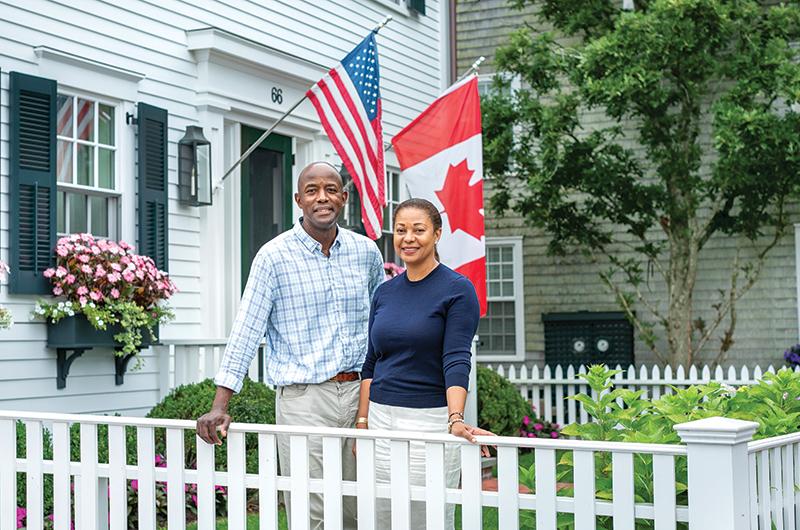
In doing so, they joined a long list of venerable owners who have called the 1820 Federal and Greek Revival–style structure home. According to the Massachusetts Historical Commission, those owners include cooper Tristram E. Butler, whose name once appeared over the door, and Henry A. Pease. The latter helped usher in the twentieth century while serving as the Edgartown postmaster.
As a building of historical significance, the Edgartown Historic District Commission requires any restoration to protect the building’s “distinctive characteristics and architecture.” The Murrells, both medical professionals from Ontario, wanted to preserve the historic character of the home while bringing it into a new era suitable for comfortable family living. But doing so would take time. All told, it would be several years before the self-described “wanna-be-Americans” would see the Canadian flag flying beside the American flag on the front poles.
Already versed in the Vineyard vernacular from the Simpsons Lane project, Fred and Liza once again engaged architect Ahearn to design their new house and obtain the necessary historic district commission approvals. They also called upon Dee Dee Taylor Eustace, a Toronto-based interior designer and architect, and Able Moraine, a local design firm, to create a home for “easy living.” Together, the couple and their team collaborated on every aspect of the home’s design – from the mudroom to the primary bedroom – to create a practical, comfortable home with a touch of grandeur befitting one of the Island’s most historic addresses. Because the house is situated in the center of the historic district, the Murrells were especially intentional about respecting the façade. Their goal was to capture the essence of the home while adding what Fred described as “Vineyard flair.”
Locally, it was up to the Waterfront Builders team of Robbie Robinson and Tom McDonald to bring those ideas to life. “The first challenge was building a new frame into an old house” to replace the old, decaying one, recalled Robinson. Another hurdle was communicating over FaceTime since the Murrell family would not see the house until it was fully framed.
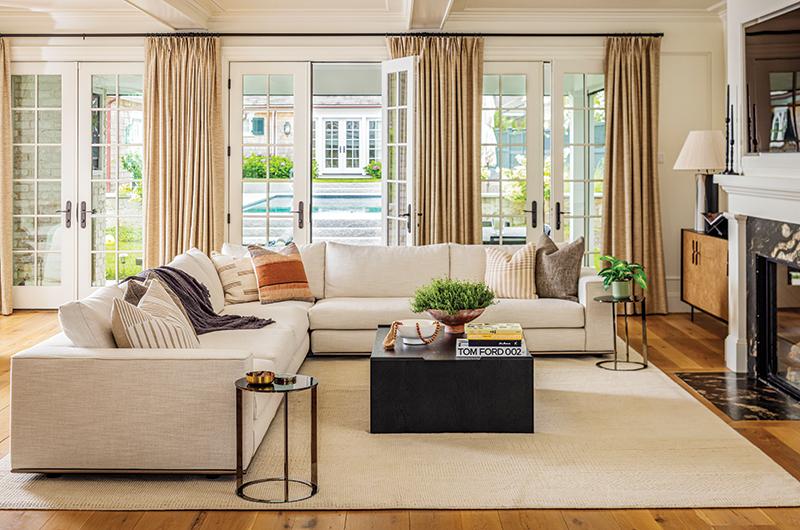
“With the pandemic, we put our heart and soul into the project” he said, “and working with the Murrells and finally getting to know their great kids when they were able to come back to the Island made it really special.”
Today, the classic clapboard exterior, which includes a pair of built-in benches typical of the street’s front stoops, reflects the house’s two-hundred-year history and anchors a line of desirable homes extending to the Harbor View Hotel.
But while the façade is a nod to the past, the inside resembles a grand, contemporary home where the most important design aesthetic is family. Fred’s design priority was to create enough space “where we can all be together and not feel cut off from the rest of the family.” In summer, and again at Thanksgiving, the extended group can swell to more than twenty. The Murrells took care to accommodate multiple generations in every design detail, from a fully finished basement entertaining area to a combined kitchen and living space in the great room.
Entering through the front door, guests are immediately struck by the length of the hall. Large-framed paneling on the walls and detailed moldings on door frames and archways further convey stateliness. A graceful, extra-wide staircase with carved balustrade does not interrupt the straight view through to the airy great room, a pool, and a pergola-topped guest house in an elevated hardscape at the end of the property.

An intimate living room and an office space off the front hall are reminiscent of the home’s original layout, when a series of small rooms or parlors reflected the design of the period. The centerpiece of the front living room is a paneled fireplace with a light-colored onyx hearth. It is an example of Liza’s efforts to “become a bit of an expert in stones and finishes.” Further evidence of her expertise is seen in the home’s additional fireplaces, all in different marble finishes. A cool summer retreat or a cozy corner on a stormy day, the living room’s soft whites set the tone for the muted colors that continue throughout the house.
The deliberately monochromatic color scheme with subtle earth tones draws the eye toward pops of color in the couple’s carefully curated art collection. Liza is a trustee of the prestigious Art Gallery of Ontario and, along with Fred, was instrumental in securing a large collection of Caribbean historical photographs at that gallery. She takes pride in selecting artwork for their Edgartown home.
Most prominent in the front living room is a large piece by photographer Tyler Mitchell, noted as the first African American to shoot a Vogue magazine cover. His image of four young women balancing on stilts on a grassy scene with blue sky “spoke” to Liza, she said. “It’s a view that could very well be the Vineyard. And, of course, I have daughters.”
Among her most important historical pieces is a 1965 portrait of two young girls by civil rights photographer and filmmaker Gordon Parks. She is also drawn to mixed-media work. Two collages bring vibrant color and texture to the front hall: Grass by Maria-Lana Queen and a piece by Ekua Holmes depicting figures on a beach.
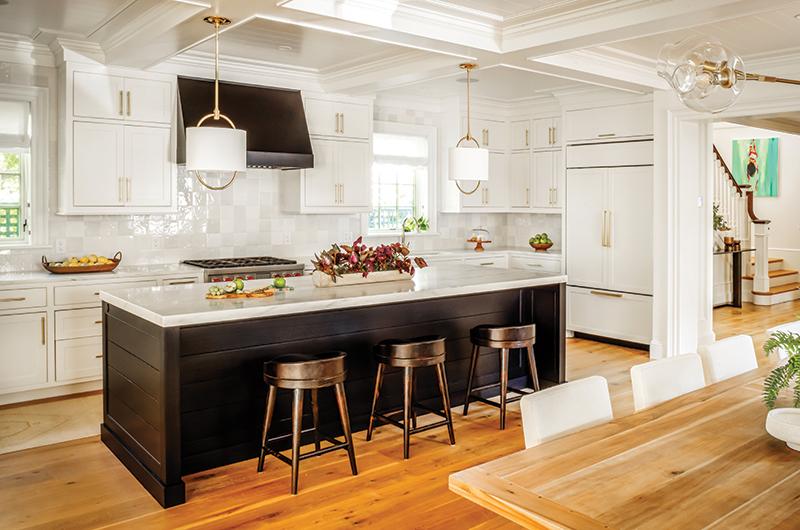
“I had never seen people like us in a beach scene,” said Liza – that is until she found Holmes’s work at Cousen Rose Gallery in Oak Bluffs.
The center of family action is the oversized kitchen island in the great room, where Fred commands the cooktop while the Murrell kids, all around college age, gather for conversation, occasional schoolwork, and Lakers games. Deep counters accommodate kitchen systems designed for a crowd: double ovens, dishwashers, prep sinks, and floor-to-ceiling paneled cabinets that conceal a trove of chef’s tools. A large dining table and generous seating area center the room.
A wide opening leads to an adjacent breakfast area, where a custom oval table can accommodate spillover crowds who are treated to views of North Water Street and a peak of the Edgartown Harbor. After dinner, three generations of family members have plenty of room to take a turn moving to Fred’s “old school” and the kid’s “new school” tunes by an elegant smoky marble bar.
The fun continues in the basement level, where extensive foundation work allowed them to create not just a finished space but valuable real estate used in all seasons. The Murrells maximized the square footage, creating another large living room with laundry amenities – a choice refuge when the house overflows with family. But the biggest draw is a stylish screening room with deep, plush seating and touch-of-a-button technology where they show family favorites, including James Bond movies. Their love for the 007 canon is evidenced in the framed movie posters that grace sound-absorbing fabric walls.
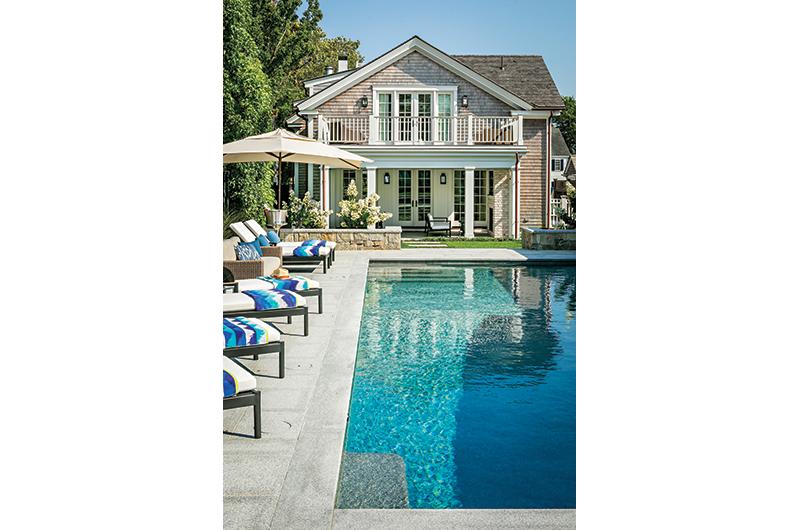
While the Murrells were drawn to the prestige and beauty of the historic home, the previously untapped potential of the deep property was an especially exciting prospect. They engaged the long-established Island landscape design and groundskeeping firm Avant Gardener to lay out a plan that combined formality and recreation. Every bit of the lot is used to create an ultimate outdoor entertaining space, complete with verdant grounds, granite walkways, and a raised forty-by-fifteen-foot pool that serves as the centerpiece of the outdoor space.
It’s easy to imagine the happy sounds of summer: twenty-somethings splashing and diving to the pool’s nine-foot depths, laughter from the loungers on the stylish pool chaises, and the crunch of ice as bottles of wine and sparkling drinks are pulled from an oversized pewter pedestal. A flagstone porch enclosed by almost transparent, motorized retractable screens offers a clear view of the fun, further demonstrating the Murrells’ edict to keep the family environments connected.
A perfect day by the pool often ends with a climb to the home’s widow’s walk, a signature embellishment of many historic whaling captains’ homes. While the name of the rooftop balcony is said to be derived from romantic tales of captains’ wives watching the horizon for a safe return, according to Island historian Matthew Stackpole, “historically, the structures were built for quick access to the roof to fight a chimney fire.” Today, it more typically means quick access to “the family’s favorite Instagram shot” – selfies with a backdrop of the Chappaquiddick shoreline and the line of chimneys that stretch up North Water Street like sentinels keeping watch on Edgartown Harbor.
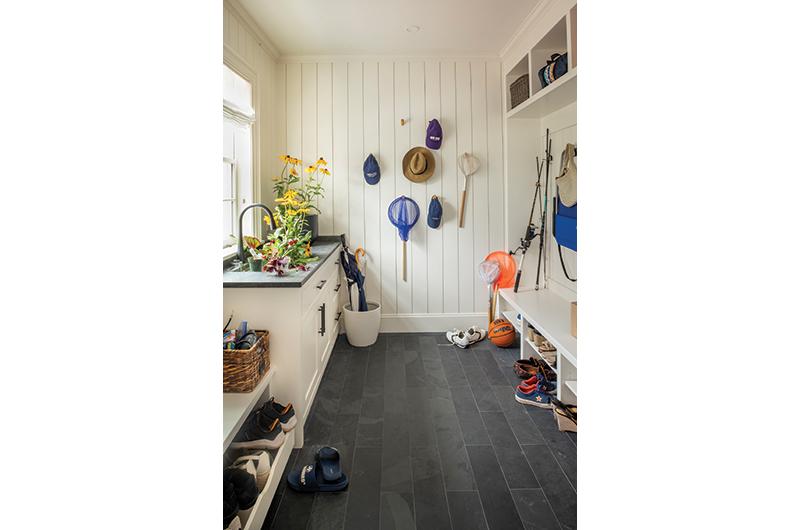
Late this spring, following a “marathon” renovation process, the Murrells put the finishing touch on their property: an elegant herringbone-patterned driveway in one of the Edgartown Historic District Commission’s preferred materials: classic red brick. The intricate pattern runs the length of the house, giving passers-by a glimpse of the depth of the lot. Liza professed to “a few mishaps and agonizing over the design” which, now that it is done, elicits many compliments from neighbors and onlookers strolling the historic block.
The striking color is accentuated by the Canadian maple leaf and American stripes that flank the front door. The flagstaffs signal a new family’s legacy on North Water Street, one that has created an Edgartown home to endure, and “a place of peace and happiness for our family to coalesce, share time, establish traditions, and share love.”
The print version of this article incorrectly stated the architect of the project. The home was designed by Patrick Ahearn Architect. We apologize for the error.

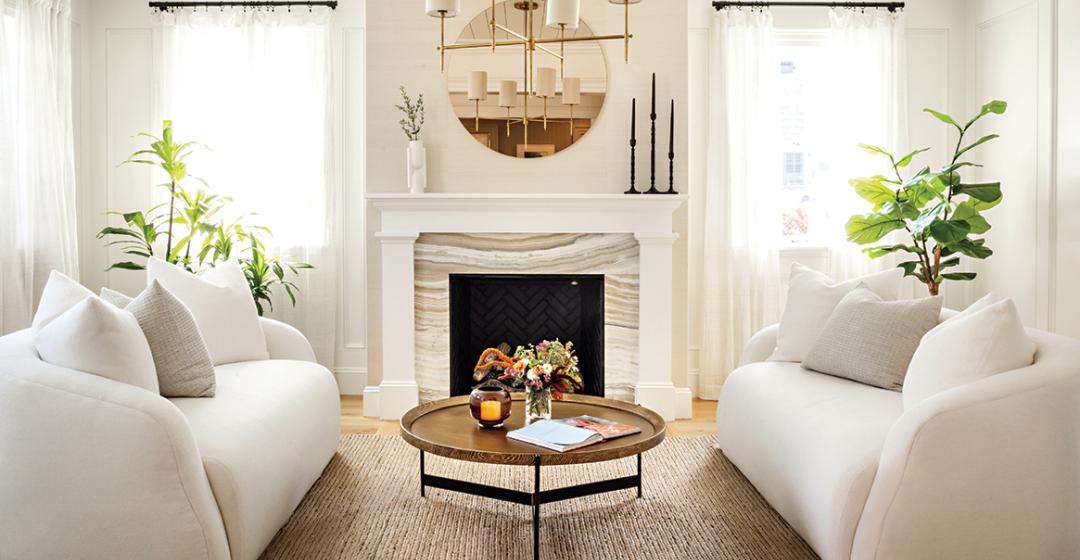


 1 comment
1 comment
Comments (1)